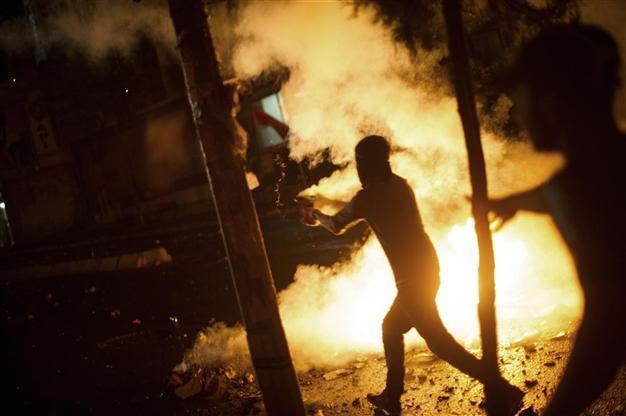Istanbul’s Gazi stages fiery clashes despite Gezi Park detente
ISTANBUL

A demonstrator runs toward police and security forces launching fireworks on a third consecutive night of clashes with riot police in Istanbul's Gazi neighborhood on June 8. AFP PHOTO / ZAC BAILLIE
Istanbul’s working-class and predominantly Alevi neighborhood of Gazi continues to see heavy clashes with police. The clashes come long after security forces withdrew from Taksim Square, leaving Gezi Park and the square to the protesters’ occupation.Every night since the unrest began, more than 15,000 people have gathered at 9 p.m. in the district of Sultanbeyli’s Gazi neighborhood center, according to daily Radikal’s report published on June 10.
The protesters use the same method as the Taksim occupiers, blocking the neighborhood’s entrance with barricades and clashing with police to prevent an intervention in the protest.
Police officers used TOMA, a vehicle used to intervene in public incidents, water cannon, and tear gas to disperse the group.
Veli Gülsoy, the head of Gazi Cemevi (Alevi house of worship) said what was happening in the Gazi neighborhood was a reaction to the government by ordinary people, daily Radikal reported.
Gülsoy also said naming Istanbul’s third bridge after an Ottoman sultan historically known for slaughtering Alevis, “Yavuz Sultan Süleyman,” was an important reason for locals to riot.
The neighborhood, predominantly populated by Alevis, witnessed mass demonstrations in 1995 after 23 people were killed in four days of unrest, 17 of them by police bullets, according to forensics reports.
The events, known as the Gazi riots, were triggered after unidentified assailants randomly opened fire on people in a local coffeehouse in March 1995, wounding dozens and killing two, one of them an Alevi religious leader. Locals, who blamed the deaths on an inadequate police response, overran police stations and started a brief uprising that was only contained after soldiers were deployed in place of the hated police.
“Now the situation in Gazi is even worse than what happened in 1995,” a member of the Socialist Democracy Party (SDP) was quoted as saying by the BBC’s Turkish service.
“This is a politically motivated neighborhood, a politicized place. There is no single person here who did not taste tear gas,” Halil Sönmez, a 25-year-old member of the SDP, reportedly said.
Sönmez was hit with two gas canisters last week, according to the report.
The unrest, which resulted in the deaths of three people – a police officer and two protesters – and close to 5,000 injured around the country, continues in the capital of Ankara as well.
















